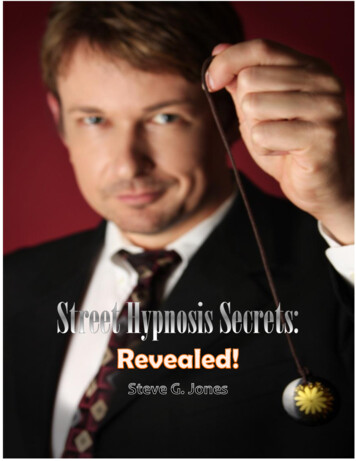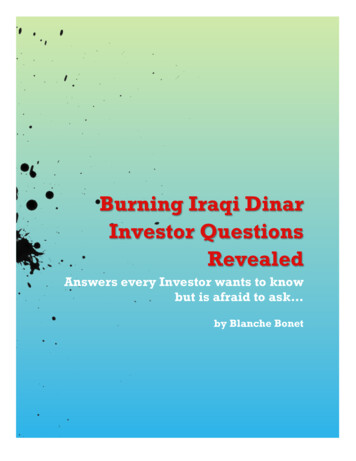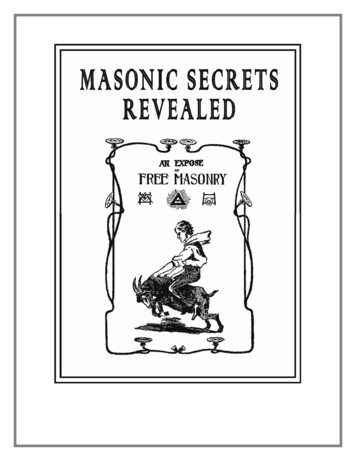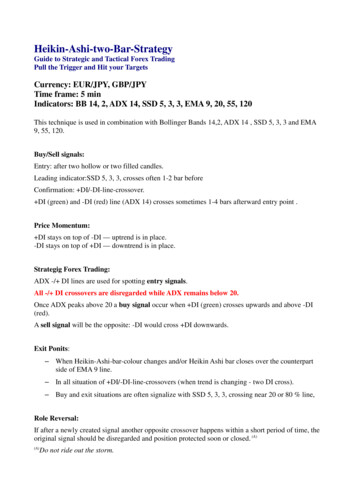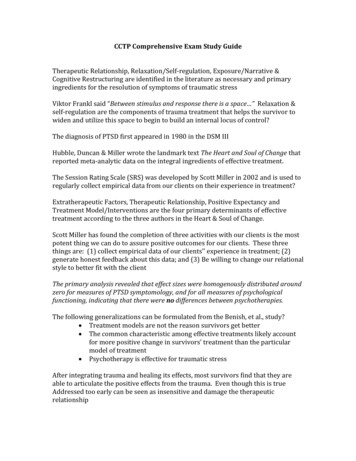
Transcription
CCTP Comprehensive Exam Study GuideTherapeutic Relationship, Relaxation/Self-regulation, Exposure/Narrative &Cognitive Restructuring are identified in the literature as necessary and primaryingredients for the resolution of symptoms of traumatic stressViktor Frankl said “Between stimulus and response there is a space ” Relaxation &self-regulation are the components of trauma treatment that helps the survivor towiden and utilize this space to begin to build an internal locus of control?The diagnosis of PTSD first appeared in 1980 in the DSM IIIHubble, Duncan & Miller wrote the landmark text The Heart and Soul of Change thatreported meta-analytic data on the integral ingredients of effective treatment.The Session Rating Scale (SRS) was developed by Scott Miller in 2002 and is used toregularly collect empirical data from our clients on their experience in treatment?Extratherapeutic Factors, Therapeutic Relationship, Positive Expectancy andTreatment Model/Interventions are the four primary determinants of effectivetreatment according to the three authors in the Heart & Soul of Change.Scott Miller has found the completion of three activities with our clients is the mostpotent thing we can do to assure positive outcomes for our clients. These threethings are: (1) collect empirical data of our clients’’ experience in treatment; (2)generate honest feedback about this data; and (3) Be willing to change our relationalstyle to better fit with the clientThe primary analysis revealed that effect sizes were homogenously distributed aroundzero for measures of PTSD symptomology, and for all measures of psychologicalfunctioning, indicating that there were no differences between psychotherapies.The following generalizations can be formulated from the Benish, et al., study? Treatment models are not the reason survivors get better The common characteristic among effective treatments likely accountfor more positive change in survivors’ treatment than the particularmodel of treatment Psychotherapy is effective for traumatic stressAfter integrating trauma and healing its effects, most survivors find that they areable to articulate the positive effects from the trauma. Even though this is trueAddressed too early can be seen as insensitive and damage the therapeuticrelationship
According to the material presented in the course, the Anterior Cingulate Cortexseems to play the most significant role in our perception of threat when there is no“real” danger.Assessing the volume and activity of the Anterior Cingulate Cortex has beenemerging as an important indicator of successful treatment outcomes?By self-regulating—intentionally relaxing one’s body in the context of a perceivedthreat—it has been demonstrated that an individual can realize three importantbenefits. These are: Comfort in one’s body Restoration of maximal neo-cortical functioning Intentional instead of reactive behaviorThe relational aspects of treatment have been well-documented in many metaanalytic studies as the most powerful predictor of positive outcomes (of thoseinfluenced by the practitioner) for our clients.Positive expectance/Placebo/Hope has been well documented in many metaanalytic studies as the second most powerful predictor of positive outcomes (ofthose influenced by the practitioner) for our clients.Sympathetic dominance has the following physiological effects: Muscle tension Elevated heart rate Elevated respiration rateThe autonomic nervous system is comprised of the parasympathetic andsympathetic systemsComfort, relaxation, satiety are best associated with the parasympathetic branch ofthe autonomic nervous system?Perceived threat activates the SNS.Remaining in the context of a perceived threat without intentionally relaxing one’sbody yields: Sympathetic dominance Anxiety symptoms Compulsive behaviorThe ability to become intentional—which could be defined as the opposite ofposttraumatic reactivity—is predicated upon the person’s ability to relax/selfregulate their ANS.
Relaxation requires dissociation from the activities of daily living while selfregulation is employed “in the moment” This best defines the difference between“relaxation” and “self-regulation”“Trauma is an injury, not an illness.” Trauma damages the brain of the survivor—itnever again follows the same neural firing patterns that it did before the traumaA helpful way to explain trauma symptoms to patients might be: Over-adaptation in the present to painful past events of the past Evidence of a self-healing system at work As a normal person have a normal response to abnormal events in one’slifeWhen a clinician can assist a survivor in completing a trauma narrative that includesall the microvents of that trauma and then helps them to share this narrative with arelaxed body then they gain Resolution of re-experiencing symptoms (nightmaresand flashbacks) associated with that traumaPeri-traumatic dissociation has been identified by Charles Marmar as the mostpowerful predictor of future PTSD symptoms?The Clinician Administered PTSD Scale (CAPS), developed by the National Center forPTSD, can be utilized for: Conferring the diagnosis of PTSD Psychoeducation about trauma with our clients Determining the acuity of PTSD symptomsThe CAPS primarily evaluates the frequency, intensity and severity of the 20symptoms of PTSD in Criteria B, C, D & ESleep problems, irritability, difficulty concentrating are examples of symptoms inCriterion E – Arousal & Reactivity.Symptoms in Criterion B (Intrusion) would be best illustrated by nightmares,flashbacks and psychological/physiological distress when remembering the trauma.1. In the DSM V, there are only three types of events that meet diagnostic thresholdin Criterion A. These are: Death, Serious Injury, and Sexual ViolenceHow many symptoms need to be endorsed by our patients in Criterion B, C, D & E,respectively, to confer the diagnosis of PTSD? 1-1-2-2On the CAPS, a severity score of 2 or higher is endorsement of that particularsymptom by the survivor.
Stigmatizing the survivor is NOT an important function of the CAPS.On the PCL-5, two items between #8 – 14 must the client score a two or higher tomeet diagnostic threshold for Criterion D of PTSD.The Trauma Recovery Scale (TRS) performs the following important function(s): Solution focused assessment of trauma symptoms Inventory of traumatic experiences throughout lifespan Treatment planning aidThe TRS is BEST used for ongoing measurement of treatment effectiveness.A total score of 95 on the TRS would best describe mild to nonexistent PTSDsymptomsSafety/Stabilization, Remembrance & Mourning, Reconnection describe the TriPhasic Model for PTSD treatment.Judith Herman (1992) made the following contribution to the treatment of traumasurvivors Wrote Trauma and Recovery Promulgated the Tri-Phasic Model for Treatment Was primary impetus for the birth of the field of traumatologyProviding client with skills necessary to stabilize and navigate successfully throughtrauma treatment best defines the primary focus of the Safety/Stabilization Phase oftreatment.Grieving losses is NOT a task associated with the Safety/Stabilization Phase oftreatment?The following are good argument for the importance of teaching clients and thenhaving them demonstrate self-rescue from abreactions in the Safety Phase oftreatment: So that they can extricate themselves from overwhelming memoriesand emotions when they are on their own So that the client, and not the therapist, is responsible to for rescuingthemselves when/if they get overwhelmed during trauma work To help the client feel more prepared and competent when addressingtraumatic materialA startle is a sudden and overwhelming perception of threat.
Startle; Thwarted Intention (fight or flight); Freeze; Altered State/Peri-traumaticDissociation; Body Memory; and Resolution are the phases of The InstinctualTrauma Response (Tinnin, 1994; 2013).About 10% of American develop PTSD sometime during the course of their lifetime.Pierre Janet, a neurologist/psychiatrist in Paris discovered an effective treatmentfor PTSD (hysteria) in the late 1800s.Cognitive-Behavioral Therapy (CBT) incorporates homework, Stoic philosophy,inductive reasoning, psychoeducation, relaxation training, exposure, selfassessment, and therapeutic alliance to help clients heal from trauma.Medication is NOT a component of EMDR?Reciprocal inhibition, described by Joseph Wolpe in the 1950s, can be defined as The integral component of ALL effective trauma therapy The pairing of exposure and relaxation The idea that anxiety and relaxation cannot coexist in the sametime/placePatricia Resick is the developer of Cognitive Processing Therapy CPT); a SAMSHAapproved evidence-based treatment for traumatic stress.Thought Field Therapy, one of the first treatment approaches to capitalize on theconcept of emergency manipulation, was developed by Roger Callahan.EMDR, PE, DTE, CPT, TIR and Hypnotherapy have all demonstrated evidence-basedeffectiveness with PTSDThe Graphic Time Line, Written Narrative, Pictorial Narrative, Verbal Narrative andRecursive Narrative are components of the IATP 5-Narrative Model; a CBT approachto treating trauma?The Recursive Narrative, in which the therapist tells back the client’s narrative tothem as a story, is hypothesizes to serve the following purposes: Help clients to shift from first-person “field memories” to third-person“observer memories” of their trauma To further desensitize their negative arousal To demonstrate to them that they are no longer carrying this memoryby themselves—that is now a shared narrativeAttachment trauma can be caused by: An anxious caregiver Over-indulgence
Pre-verbal traumaAutogenesis, diaphragmatic breathing, meditation, and guided visualization are allexamples of relaxation strategies.According to Worden, grieving in the first year should be supported.Adverse childhood experiences can lead to: Early death Cognitive impairment Social impairmentPsychotherapy involves neural plasticity a therapeutic relationship positive expectancyFrankl praised mankind’s ability to make choicesPrevalence rates of PTSD from the research of OEF/OIF veterans are estimated to be20%.Daniell has written about intergenerational transmission of the symptoms of PTSD.According to Benish, Imel and Wampold most bona fide therapy models workequally well in treating traumaBisson & Andrew believe and demonstrated x trauma focused therapy are moreeffective in the treatment of trauma than non-trauma focused treatmentIn most studies of treatment conducted over the last 40 years, the average treatedperson is better off than 80% of the untreated sample.Research shows approximately 1 out of 10 clients on the average clinician’s caseloadis not making any progressAccording to Lambert 15% of improvement in psychotherapy patients as a functionof the therapeutic model and techniques.According to Lambert 75% of the therapist’s influence on treatment outcomes liesin relational factors.Self-mutilation is not an active ingredient for positive outcomes?The following are an evidence-based way to improve outcomes in therapy:
Collect empirical data evaluating the quality of the therapeuticrelationshipGenerate honest feedback from client on methods to improve therapy(i.e. relational)Be willing to change toward what works best for client—demonstratethat changeIndividuals with traumatic stress issues often have difficulty distinguishing between“being safe” and “feeling safe”.Reciprocal inhibition is a term first introduced by Joseph Wolpe.Sympathetic dominance is associated with the fight-or-flight reflex.The amygdala permanently encodes fear & triggers affective memoriesGlutamate is the most excitatory neurotransmitter.A traumatic response involves a shut down of the neo-cortexMost posttraumatic responses make good sense when viewed in the context of thesurvivor’s life.Bilateral stimulation is helpful in regulating affectPIDIB is helpful in developing a rapid case conceptualizationHerman’s model clarifies: Safety and stabilization Remembrance and Mourning ReconnectionRestructuring all cognitive distortions is not one of Gentry’s six empirical markers?The following are basics of trauma treatment Reciprocal Inhibition Bilateral Stimulation Non Anxious PresenceTrauma treatment is mainly exposure and cognitive therapyEMDR is one of the most researched trauma sensitive clinical interventions
Relaxation requires dissociation from the activities of daily living while self-regulation is employed “in the moment” This best defines the difference between “relaxation” and “self-regulation” “Trauma is an injury, not an illness.” Trauma damages the brain of the survivor—it never again follows the same neural firing patterns that it did before the trauma A helpful way to .





